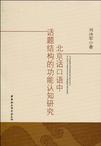北京话口语中话题结构的功能认知研究
出版时间:2010年 出版社:中国社会科学出版社 作者:刘林军 页数:306
Tag标签:无
前言
话题作为一个重要的语言学概念已有几十年的历史。1958年Charles Hocket注意到有些汉语句子的主谓式里包含主谓式,像个套盒。1968年,赵元任第一个把话题-述题的概念引入汉语,指出汉语的主语-谓语关系就是话题-述题关系。1976年,Charles Li和Sandra Thompson从类型学的角度进行语言分类,把汉语归为话题优先的语言以别于英语这样的主语优先的语言。他们两人的论述对话题研究产生了很大的影响,也引起了不少争议,但从此以后,语言学界,特别是我国语言学界对话题的研究不断涌现。 话题研究无疑具有重要的意义。这是因为话题-述题是汉语的显著特点,对它的研究将使我们能够科学地描写和解释汉语的这个特点,具有实际和理论价值。另一方面,对话题的研究会有助于语言类型学的发展,因此具有一般语言学意义。 迄今我国语言学界对话题的研究基本是从结构-功能,或者说是从句法-语用的角度进行的。运用认知语言学的理论和方法研究话题的文章相当少,而写成专著的恐怕更是凤毛麟角了。
内容概要
《北京话口语中话题结构的功能认知研究》采用认知和功能相结合的研究方法,对北京话口语语料进行分析,指出认知参照点模式可以对汉语中的话题做出统一的解释,实际语言运用中的各式话题结构可视为认知参照点模式的具体实例。本研究重点考察停顿和几个高频话题标记在北京话口语中的使用情况,对各自的使用的频率、语境和功能进行全面而系统的分析。进而,《北京话口语中话题结构的功能认知研究》对汉语话题所构成的认知参照点模式从横向和纵向两个方面进行勾勒,指出话题既可以是述题的主观参照点,也可以是客观参照点,从而发展了Langacker(1991,1993,1998)把话题作为主观参照点的理论。
作者简介
刘林军,1970年生。北京语言大学外国语学院副教授、硕士生导师,主要从事语言学与翻译学的研究。已有译著及多篇学术论文发表。
书籍目录
List of AbbreviationsList of TablesList of FiguresChapter 1 Introduction1.1 The Issue1.2 Cognitive Linguistics as an Alternative1.3 A Corpus Approach1.4 Monograph ChaptersChapter 2 Review of Previous Studies on Mandarin Topics and the Cognitive Approach as an Alternative2.1 Findings on and Controversies over Topic2.2 A Cognitive Approach to Topic2.3 Findings in Other Topic-Prominent LanguagesChapter 3 Pauses and Pause Particles as Topic Markers in Mandarin3.1 Pauses as Topic Markers3.2 Pause Particles as Topic Markers3.3 Discourse Use of Pause Particles in Beijing MandarinChapter 4 Methodology of a Corpus Study4.1 A Coding Property Based Approach to Topic Identification4.2 Defining Some Grammatical Terms4.3 Data: The Beijing Corpus4.4 Corpus Analysis Procedure4.5 Research GoalsChapter 5 Pausing and Topic Marking5.1 Pausing in Nominal Constructions5.2 Pausing in Double-Subject Constructions5.3 Pausing in TOP-subject Constructions5.4 SummaryChapter 6 High Frequency Topic Markers in Beijing Mandarin6.1 Pause Particle ne6.2 Pause Particle ba6.3 Pause particle a and its phonetic variants6.4 Pause particle ma6.5 Lexical topic marker dehua if and laijiang speaking of6.6 Discussion6.7 SummaryChapter 7 A Unified Interpretation of Topic as Conceptual Reference Point7.1 Reference Points are more than entities7.2 Reference Points can be multiple7.3 Schematizing Topic-Comment Constructions7.4 SummaryChapter 8 Conclusion8.1 A Brief Review8.2 Revisiting the Controversies over Mandarin Topics8.3 Reference Point as a Conceptual Archetype8.4 Areas of Further StudyAppendix : Characteristics of Monologues Comprising the CorpusReferences
章节摘录
Cogntive hnguistics is a cover term for a variety of approaches, methodologies and emphases which are unified by a number of assumptions. Foremost among these assumptions is the belief that language forms an integral part of human cognition, and that any insightful analysis of linguistic phenomena will need to be embedded in what is known about human cognitive abilities. Accordingly, cognitive linguistics aims for a cognitively plausible account of what it means to know a language, how languages are acquired and how they are used. The foundational point of cognitive linguistics is simply that "language is all about meaning"; that is, language is viewed as an instrument for organizing, processing and conveying information (Geeraerts 2008:3). To cognitive linguists, a formal semantics based on truth conditions is inadequate for describing the meaning of linguistic expressions. Langacker (2008:29) suggests two reasons: " One reason is that semantic structures are characterized relative to knowledge systems whose scope is essentially open-ended. A second is that their value reflects not only the content of a conceived situation, but also how this content is structured and construed. "
图书封面
图书标签Tags
无
评论、评分、阅读与下载
